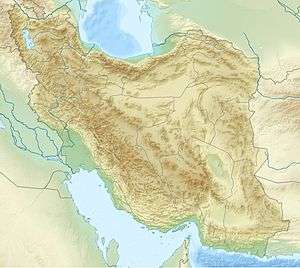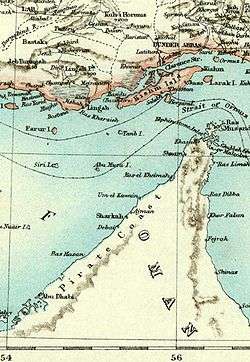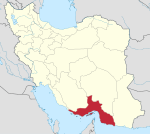Abu Musa
| Disputed island Other names: Persian: ابوموسی | |
|---|---|
 | |
| Abu Musa Island in the Persian Gulf | |
| Geography | |
 | |
| Location | Persian Gulf |
| Coordinates | 25°52′N 55°02′E / 25.867°N 55.033°E |
| Total islands | 1 |
| Area | 12.8 km2 (4.9 sq mi) |
| Highest point | Mount Halva 110 m (360 ft) |
| Administered by | |
| Iran | |
| Province | Hormozgan |
| Largest city | Abu Musa (1,953) |
| Claimed by | |
| [[{{{country claim}}}]] | |
| Demographics | |
| Population | 2,131 (as of 2012) |
| Ethnic groups | Iranians |
 Iran | |
| Location |
Abu Musa Iran |
|---|---|
| Coordinates | 25°53′06.5″N 55°02′02.2″E / 25.885139°N 55.033944°E |
| Construction | masonry tower |
| Tower shape | square short tower atop building |
| Focal height | 130 metres (430 ft) |
| Range | 9 nautical miles (17 km; 10 mi) |
| Characteristic | Fl W 8s. |
| Admiralty number | D7706 |
| NGA number |
28744[1] [2] |
Abu Musa (Persian: ابوموسی ![]() listen Island is a 12.8 square kilometer (4.9 sq mi) Iranian island in the eastern Persian Gulf near the entrance to the Strait of Hormuz.[3] Due to the depth of sea, oil tankers and big ships have to pass between Abu Musa and Greater and Lesser Tunbs; this makes these islands some of the most strategic points in the Persian Gulf.[4] The island is administered by Iran as part of its province of Hormozgan, but is also claimed by the United Arab Emirates as a territory of the emirate of Sharjah.[5][6]
listen Island is a 12.8 square kilometer (4.9 sq mi) Iranian island in the eastern Persian Gulf near the entrance to the Strait of Hormuz.[3] Due to the depth of sea, oil tankers and big ships have to pass between Abu Musa and Greater and Lesser Tunbs; this makes these islands some of the most strategic points in the Persian Gulf.[4] The island is administered by Iran as part of its province of Hormozgan, but is also claimed by the United Arab Emirates as a territory of the emirate of Sharjah.[5][6]
Name
Abu Musa's inhabitants call it "Gap-sabzu" (Persian: گپسبزو), which in Persian means "the great green place." On old maps, the island is called:
- "Boum-Ouw" (Persian: بوماوو) or "Boum-Ouf" (Persian: بوماوف) which in Persian means "Waterland".
- "Boum-Souz" (Persian: بومسوز) or "Boum-Sou"/"Boum-Souw" (Persian: بومسو) or "Gap-Sabzou" (Persian: گپسبزو) which in Persian means "Green Land".[7]
However, in recent centuries it has also been called Bum Musa, Persian for "the land of Musa/Moses," instead of "Boum-Sou".[8]
Geography
Abu Musa island is located 70 kilometres (43 mi) south of Bandar-e Shenas and 65 kilometres (40 mi) north-northwest of Sharjah. Out of 14 islands of Hormozgan it is the island farthest from the Iranian coast. Its highest point is the 110 metres (360 ft) Mount Halva.[9] Abu Musa city is the center of the island. The weather in Abu Musa is warm and humid, although, compared to the place in the Persian Gulf, Abu Musa has a better climate and the most diverse ecosystem, but it lacks suitable soil and water for farming leaving fishing as the main industry for locals. It is one of the main ports for exporting oil from Iran.
History

The sovereignty of Iran on Abu Musa has been disputed by UAE, which inherited the dispute in 1971.[10][11] By common consent, the island had been under the control of the Qasimi ruler of Sharjah.[12][13] In 1906, the ruler of Sharjah's uncle awarded a concession for the iron oxide deposits of Abu Musa to three Arabs, whose workers extracted the mineral and agreed to sell it to Wonckhaus, a German enterprise. However, when the ruler discovered this, he cancelled the concession and the workers were removed from the island with assistance from the British, resulting in an international incident.[14][15]
After 1908, the UK controlled the island along with the other British-held islands in the Persian Gulf, including what is today the UAE. In the late 1960s, the UK transferred administration of the island to the British-appointed Sharjah, one of the seven sheikdoms that would later form the UAE.
After the UK announced in 1968 that it would end its administrative and military positions in the Persian Gulf, Iran moved to reattach the island politically to the mainland. On November 30, 1971 (two days before the official establishment of UAE), Iran and Sharjah signed a Memorandum of Understanding. They agreed to allow Sharjah to have a local police station and Iran to station troops on the island according to the map attached to the Memorandum of Understanding.[13] The agreement also divided the island's energy resources between the two signatories. "By agreeing to the pact, the tiny emirate prevented an invasion by Iran, which two days earlier had taken two other disputed islands, Greater and Lesser Tunb, which were even smaller and uninhabited."[16]
One day before the UK officially left the region, Iran stationed its troops on the island and was officially welcomed by the Sheik of Sharjah's brother; Sheik Saghar.[17]
The UAE took its sovereignty claim over Abu Musa and the two Tunb islands to the 9 December 1971 meeting of the United Nations Security Council. At that meeting, it was decided to "defer consideration of this matter to a later date".[18][19] Iraq (Ahmed Hassan al-Bakr era),[20] Kuwait,[21] Algeria,[22] South Yemen[22] and Libya[22] held the view that the territory rightfully belongs to the UAE.[23][24][25][26][27] Since that time, the UAE has consistently called in public statements[19][28] for either bilateral negotiations or by referring the issue to the International Court of Justice (or another form of international arbitration).[29]
Saddam Hussein attempted to justify the Iran–Iraq War by claiming that one of the objectives was to "liberate" Abu Musa and Greater and Lesser Tunbs in the Persian Gulf. In 1992, Iran expelled foreign workers who operated the UAE-sponsored school, medical clinic, and power-generating station.[30] The Island dispute has also caused serious friction between Ras al-Khaimah and Sharjah on one hand and some other emirates of the UAE on the other hand. Ras Al Khaimah advocates tough measures against Iran. Dubai, on the other hand, believes that the conflict is unnecessary. The present ruler of Dubai (who is also Vice President, Prime Minister and Defence Minister of the UAE), Mohammed bin Rashid Al Maktoum, has earlier stated publicly that "he believes the tensions over the islands have been fabricated by the United States".[31]
In 2012 a visit to the island by Iranian president Ahmedinejad provoked a diplomatic incident.[32] Iran's historical claim to ownership over the islands roots back to the Parthian and Sassanid Empires, among others.[33] Iran considers the island to have been occupied by the UK and refers to the agreement between Iran and the emirate of Sharjah in 1971.[13]
Demographics
As of 2012, the island had about 2,131 inhabitants, making it Iran's smallest county.[34] The city of Abu Musa had 1,953 inhabitants in 2012, up 248 from 2006.[35]
Most of residents of the island speak the "Bandari" dialect of Persian.
Climate
| Climate data for Jazireh Abu Musa (1984–2010) | |||||||||||||
|---|---|---|---|---|---|---|---|---|---|---|---|---|---|
| Month | Jan | Feb | Mar | Apr | May | Jun | Jul | Aug | Sep | Oct | Nov | Dec | Year |
| Record high °C (°F) | 27.8 (82) |
29.5 (85.1) |
36.0 (96.8) |
39.6 (103.3) |
41.8 (107.2) |
42.0 (107.6) |
45.0 (113) |
41.4 (106.5) |
43.0 (109.4) |
43.0 (109.4) |
35.0 (95) |
30.0 (86) |
45.0 (113) |
| Average high °C (°F) | 23.0 (73.4) |
23.6 (74.5) |
25.5 (77.9) |
28.9 (84) |
32.5 (90.5) |
34.5 (94.1) |
36.3 (97.3) |
36.7 (98.1) |
35.4 (95.7) |
33.2 (91.8) |
29.6 (85.3) |
25.4 (77.7) |
30.4 (86.7) |
| Daily mean °C (°F) | 20.5 (68.9) |
21.0 (69.8) |
22.9 (73.2) |
26.0 (78.8) |
29.5 (85.1) |
31.6 (88.9) |
33.5 (92.3) |
33.7 (92.7) |
32.3 (90.1) |
30.0 (86) |
26.6 (79.9) |
22.7 (72.9) |
27.5 (81.5) |
| Average low °C (°F) | 18.0 (64.4) |
18.5 (65.3) |
20.3 (68.5) |
23.1 (73.6) |
26.5 (79.7) |
28.8 (83.8) |
30.6 (87.1) |
30.8 (87.4) |
29.2 (84.6) |
26.8 (80.2) |
23.7 (74.7) |
20.0 (68) |
24.7 (76.5) |
| Record low °C (°F) | 11.0 (51.8) |
8.0 (46.4) |
11.6 (52.9) |
15.8 (60.4) |
19.2 (66.6) |
23.4 (74.1) |
26.2 (79.2) |
26.8 (80.2) |
24.0 (75.2) |
19.0 (66.2) |
17.0 (62.6) |
11.0 (51.8) |
8.0 (46.4) |
| Average precipitation mm (inches) | 30.0 (1.181) |
20.1 (0.791) |
28.1 (1.106) |
6.8 (0.268) |
0.0 (0) |
0.0 (0) |
0.2 (0.008) |
0.0 (0) |
0.0 (0) |
1.6 (0.063) |
5.8 (0.228) |
33.7 (1.327) |
126.3 (4.972) |
| Average precipitation days (≥ 1.0 mm) | 2.4 | 1.9 | 2.3 | 0.7 | 0.0 | 0.0 | 0.0 | 0.0 | 0.0 | 0.1 | 0.8 | 2.8 | 11.0 |
| Average relative humidity (%) | 61 | 66 | 69 | 71 | 72 | 74 | 71 | 70 | 69 | 65 | 60 | 62 | 67 |
| Mean monthly sunshine hours | 227.4 | 225.9 | 231.6 | 267.4 | 312.4 | 315.8 | 284.7 | 294.5 | 280.5 | 293.9 | 263.4 | 228.9 | 3,226.4 |
| Source: Iran Meteorological Organization (records),[36] (temperatures),[37] (precipitation),[38] (humidity),[39] (days with precipitation),[40]
(sunshine)[41] | |||||||||||||
See also
- Iran–United Arab Emirates relations
- Seizure of Abu Musa and the Greater and Lesser Tunbs
- Sir Abu Nu'ayr
- List of lighthouses in Iran
References
- ↑ Iran The Lighthouse Directory. University of North Carolina at Chapel Hill. Retrieved 3 October 2016
- ↑ NGA List of Lights – Pub.112 Retrieved 3 October 2016
- ↑ Iranian Islands of Tunbs and Abu Musa Archived September 23, 2006, at the Wayback Machine.
- ↑ Ewan W. Anderson; Gareth Owen (1993). An atlas of world political flashpoints: a sourcebook of geopolitical crisis. Pinter Reference. p. 1. ISBN 978-1-85567-053-2.
- ↑ Fred M. Shelley (30 April 2013). Nation Shapes: The Story Behind the World's Borders. ABC-CLIO. pp. 457–. ISBN 978-1-61069-106-2.
However, the United Arab Emirates and Iran dispute control over the islands of Abu Musa, Greater Tunb, and Lesser Tunb.
- ↑ Ibrahim Abed; Peter Hellyer (2001). United Arab Emirates: A New Perspective. Trident Press Ltd. pp. 182–. ISBN 978-1-900724-47-0.
Iran claims Abu Musa Territorial and political ambitions, combined with the economic interests of influential elements within the government, helped strengthen the first Iranian claim to the island of Abu Musa in 1904. Iran began to challenge ...
- ↑ Ajam, Muḥammad. "Documents on the Persian Gulf's name: The eternal heritage of ancient time". Tehran: Evin Publication, 2009
- ↑ عجم، مجمد. «اسناد نام خلیج فارس میراثی کهن و جاودان». تهران: اوين، ۱۳۸۸
- ↑ Pirouz Mojtahed-Zadeh (January 2007). Boundary Politics and International Boundaries of Iran: A Study of the Origin, Evolution, and Implications of the Boundaries of Modern Iran with Its 1. Universal-Publishers. pp. 305–. ISBN 978-1-58112-933-5.
- ↑ ""Abu Musa and The Tumbs: The Dispute That Won't Go Away, Part Two," July 28, 2001, in The Estimate, vol. XIII, no. 3". Archived from the original on 15 December 2007. Retrieved 2008-01-06.
- ↑ ""Unwanted Guest: The Gulf Summit and Iran," 7 December 2007". Retrieved 2008-01-06.
- ↑ Ahmadi, Kourosh (2008). Islands and International Politics in the Persian Gulf: The Abu Musa and the Tunbs in Strategic Perspective. Routlege. p. 54. ISBN 0415459338.
- 1 2 3 Mojtahedzadeh, Pirouz (1993). Countries and boundaries in the geopolitical region of the Persian Gulf (in Persian). The Institute for Political and International Studies. OCLC 651081387.
- ↑ Issawi, Charles (2007). "16". In Peter Avery; et al. The Cambridge History of Iran. Volume 7 (Third ed.). Cambridge University Press. p. 605. ISBN 978-0-521-20095-0.
- ↑ 'Red oxide on Abu Musa, 1898-1934', IOR/L/PS/18/B433, in Qatar Digital Library <http://www.qdl.qa/en/archive/81055/vdc_100023442325.0x000002> [accessed 13 February 2015]
- ↑ Erdbrink, Thomas (April 30, 2012). "A Tiny Island Is Where Iran Makes a Stand". New York Times.
- ↑ Mojtahedzadeh, Pirouz (1999). Security and territoriality in the Persian Gulf. London: RoutledgeCurzon. p. 214. ISBN 0-7007-1098-1.
- ↑ Mattair, Thomas (2005). The Three Occupied Islands of the UAE: The Tunbs and Abu Musa. Abu Dhabi: Emirates Center for Strategic Studies and Research. ISBN 9948-00-765-4.
- 1 2 United Nations (1971). "Twenty-sixth Year, Supplement for October, November and December 1971". Official Records of the Security Council.
- ↑ United Nations Security Council (1972). Letter dated 72/07/17 from the representatives of Algeria, Bahrain, Egypt, Iraq, Kuwait , Lebanon, the Libyan Arab Republic, Morocco, Oman, the People's Democratic Republic of Yemen, Sudan, The Syrian Arab Republic, Tunisia, the United Arab Emirates and Yemen to the President of the Security Council (PDF). New York: United Nations Supplement, Official Record. UNDOC:S/10740.
- ↑ United Nations Security Council (1992). Letter dated 92/09/14 from the Permanent Representative of Kuwait to the United Nations addressed to the Secretary-General. New York: United Nations Annexes, Official Record. UNDOC: A/47/441.
- 1 2 3 United Nations Security Council (1971). Letter dated 71/12/03 from the representatives of Algeria, Iraq, the Libyan Arab Republic and the People's Democratic Republic of Yemen to the President of the Security Council. New York: United Nations Supplement, Official Record. UNDOC:S/10409.
- ↑ United Nations Security Council (December 1994). Letter dated 94/12/22 from the Permanent Representative of Bahrain to the United Nations addressed to the Secretary-General (PDF). New York: United Nations Annexes, Official Record. UNDOC: A/49/815.
- ↑ United Nations Security Council (1993). Letter dated 93/10/13 from the representative of Saudi Arabia to the United Nations addressed to the President of the General Assembly. New York: United Nations Annexes, Official Record. UNDOC: A/48/519.
- ↑ United Nations Security Council (September 1994). Letter dated 94/09/20 from the Permanent Representative of Saudi Arabia to the United Nations addressed to the Secretary-General (PDF). New York: United Nations Annexes, Official Record. UN DOC: A/49/412 S/1994/1078.
- ↑ United Nations Security Council (June 1995). Letter dated 95/06/21 from the Permanent Representative of Bahrain to the United Nations addressed to the Secretary-General (PDF). New York: United Nations Annexes, Official Record.
- ↑ United Nations Security Council (October 1992). Letter dated 92/10/06 from the Permanent Representative of Oman to the United Nations addressed to the President of the General Assembly (PDF). New York: United Nations Annexes, Official Record. UNDOC: A/47/516.
- ↑ United Nations (17 September 1997). "Letter dated 16 September 1997 from the Permanent Representative of the United Arab Emirates to the United Nations addressed to the Secretary-General" (PDF). United Nations General Assembly. Oceans and the Law of the Sea. 52nd Session.
- ↑ Mattair, Thomas (2005). The Three Occupied Islands of the UAE: The Tunbs and Abu Musa. Abu Dhabi: Emirates Center for Strategic Studies and Research. pp. 165–166. ISBN 9948-00-765-4.
- ↑ http://www.globalsecurity.org/wmd/world/iran/abu-musa.htm
- ↑ Rubin, Barry M. (2002). Crises in the Contemporary Persian Gulf. Routledge. pp. 44–45. ISBN 978-0-7146-5267-2.
- ↑ Ahmadinejad's visit to island prompts UAE to recall Iran ambassador, CNN April 12, 2012
- ↑ http://namak.farsnews.com/newstext.aspx?nn=9001141115
- ↑ "Archived copy". Archived from the original on 2011-06-22. Retrieved 2011-06-22.
- ↑ "Archived copy". Archived from the original on 2011-06-28. Retrieved 2010-01-27.
- ↑
- "Highest record temperature in Jazireh Abu Musa by Month 1984–2010". Iran Meteorological Organization. Retrieved April 8, 2015.
- "Lowest record temperature in Jazireh Abu Musa by Month 1984–2010". Iran Meteorological Organization. Retrieved April 8, 2015.
- ↑
- "Average Maximum temperature in Jazireh Abu Musa by Month 1984–2010". Iran Meteorological Organization. Retrieved April 8, 2015.
- "Average Mean Daily temperature in Jazireh Abu Musa by Month 1984–2010". Iran Meteorological Organization. Retrieved April 8, 2015.
- "Average Minimum temperature in Jazireh Abu Musa by Month 1984–2010". Iran Meteorological Organization. Retrieved April 8, 2015.
- ↑ "Monthly Total Precipitation in Jazireh Abu Musa by Month 1984–2010". Iran Meteorological Organization. Retrieved April 8, 2015.
- ↑ "Average relative humidity in Jazireh Abu Musa by Month 1984–2010". Iran Meteorological Organization. Retrieved April 8, 2015.
- ↑ "No. Of days with precipitation equal to or greater than 1 mm in Jazireh Abu Musa by Month 1984–2010". Iran Meteorological Organization. Retrieved April 8, 2015.
- ↑ "Monthly total sunshine hours in Jazireh Abu Musa by Month 1984–2010". Iran Meteorological Organization. Retrieved April 8, 2015.
Sources
- Haghshenas, Seyeed Ali, Iran Historical Sovereignty over the Tunbs and BuMusa Islands. 2010, Tehran.
Further reading
- Schofield, Richard (2003). Unfinished Business: Iran, the Uae, Abu Musa and the Tunbs. London: Royal Institute of International Affairs. ISBN 0-905031-90-3.
External links
| Wikimedia Commons has media related to Abu Musa. |
- History, description, map of Abu Musa and nearby islands (Archived 2009-10-24)
- History of Abu Musa and The Tunbs
- UAE Interact Abu Musa News
- Abu Musa's military garrison
- Dispute between Iran and Sharjah
- Report of the International symposium on Modern Boundaries of Iran - Problems and practices of Iranian boundaries, Pirouz Mojtahed-Zadeh, 10/15/02
- Picture of Abu Musa Lighthouse
Coordinates: 25°52′N 55°02′E / 25.867°N 55.033°E

